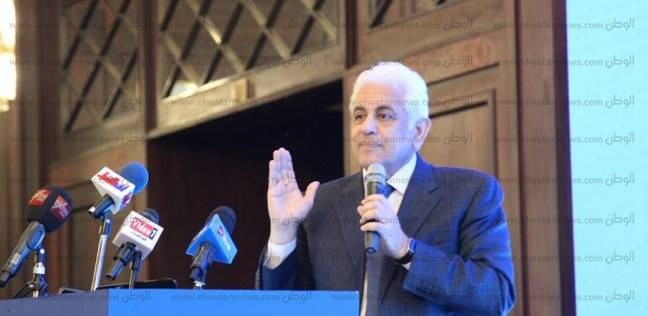Wisdom says that in every adversity there is an opportunity.. It depends on who has the ability to extract opportunities from adversity. We have been facing the spread of the “Covid-19” virus for months, and we know that one of the forms of resistance is social distancing, which led to the closure of educational institutions and the stay of more than 22 million students in their homes, and the educational process almost stopped. Its addresses are with the state, and the talk about distance education has gone too far with all its inputs as a temporary solution, and the value of the electronic calendar for students has emerged, and the ministry has announced reliance on research papers submitted by students instead of traditional exams.
The ordeal brought parents closer to their children, and forced a good number of teachers to use technology to communicate with students.
The ordeal stopped the educational system in Egypt, as if we were in a state of rebooting the entire education system, but it will return to work.. What is new is that the suspension taught us a lot, which could only be realized from the experience of stopping in the middle of the school year, which no one would have done without what happened.
We should review ourselves and not do the same thing again in the same way, waiting for different results, or else we will be among the idiots.
Activist teachers recorded educational tapes as part of the curriculum and displayed them on YouTube. There were many educational platforms used by students on the Internet, and some schools made an institutional effort to communicate with their students.
We must therefore seize the opportunity, at the level of educational districts and schools, in new initiatives for training on innovative learning methods. We should benefit from teachers who have demonstrated the ability and energy to communicate with their students outside the walls of routine and tradition.
We must encourage young people who have demonstrated the potential of building systems to transform curricula into three-dimensional materials in impressive ways, and who have created distance assessment programs at a low cost.
We must consider the possibility of transforming schools into a mixture of distance education and face-to-face education, to reduce the density of classes and to absorb new students. Of course, what I say here must respect the educational foundations and the importance of being present in the school community, but in a new way that may restore school education to its luster and value in building knowledge and creating a normal personality.
The Egyptian people deserve a real and tangible achievement in the field of education and human and human development. Out of our belief that the strength of Egypt lies in the strength of its people, and the strength of its people can only be achieved by continuous work to lay down a general framework for development, increase awareness and raise the level of knowledge and skills for this people, and that the only way to achieve this is through education, culture and meaningful information. The current situation looks optimistically, as if it has opened a new door for development and modernization. Taking into account that any new vision has no value except with the conviction of society and the commitment of successive governments to implement it and deal with its axes as the constitution of education in Egypt, and that this vision must be compatible with the changing reality and the future that we create by our own will.
Let me remind you that it is extremely important to adhere to a well-known, clear and comprehensive strategy. And that construction cannot achieve a goal if we start over with every government.
Our vision is divided into five pillars:
The first pillar: accessible education for all, of high quality, without discrimination.
The second pillar: The existence of an efficient, fair and sustainable institutional framework for the management and governance of the education, research and development process at the central level, down to the decentralized level in the governorates, to the management of schools.
The third pillar: Technological and digital empowerment of the student, student, teacher and teaching staff in the school and university, and the development of teaching methods and methods, research and evaluation. This was demonstrated by the health crisis and the closure of educational institutions.
The fourth pillar: Building the integrated personality of the student and student in all its aspects to become a normal citizen, proud of himself, enlightened, creative, proud of his country and its history, passionate about building its future, capable of difference and capable of pluralism. Note that this cannot be done without culture, art, music and exercise.
The fifth pillar: The graduate should be an initiative, have the ability to adapt to the changes around him, create new job opportunities, and be able to compete with his peers at the local, regional and global levels.
Perhaps the philosophy of dividing the vision into five axes comes for several logical reasons, the most important of which is that the vision becomes more understandable and clear to the community, and it also facilitates its follow-up and monitoring of implementation using agreed measurement indicators.
Each axis is divided into several sub-goals, and each sub-goal falls within and from which a set of performance indicators emanates. Perhaps this depth of detail was provided by the group of experts who formulated with me Egypt’s Vision 2030 in the education axis, in order to become a road map, clear and defined frameworks. It only requires successive governments to formulate an executive procedural plan for each axis with its goals and indicators, including the time frame for implementation, and specifying the budgets and costs necessary for this, as well as the responsibility for implementation from the ministry’s apparatus, and even more importantly, the formulation of success indicators that serve as clear evidence of the extent The progress that is being made for each indicator and each goal for the same axis so that the observer and the interested person can pass a transparent judgment on the performance of the executive body of the government in achieving the vision, and we facilitate the work of all the bodies that carry out monitoring and follow-up procedures, as is the case in all successful institutions in the world, in framework of transparency and integrity.
This falls under these axes or pillars previously mentioned, sub-objectives, then measurement indicators, as I said, then the expected time period for implementation as stated in the document, then monitoring results. . Without monitoring, analyzing and adjusting the
The path of the vision and the stated goals for the development of education becomes a dead letter on paper, and it must:
Monitoring the efforts of state agencies in implementing Egypt’s Vision 2030 in the axis of education, research and development, and issuing a semi-annual report in June, and an annual report in December of each year until 2030, to be published for those interested.
A review of what has been implemented in the education axis every 5 years, in light of the goals and objectives of Egypt’s Vision 2030, to set points and a new beginning if necessary.
Monitoring the gaps between the plans of the concerned ministries and the announced strategy, and the objectives of Egypt’s Vision 2030 in development.
Monitoring the reasons for not achieving the goals within their time frame.
Participate in reviewing the vision and the strategies stemming from it every period of time so that they can be developed, if necessary, in light of the development in the world.
This is clear and feasible!!!
The follow-up body should be independent of the ministry, so I appeal to civil society, the Ministry of Planning, the Central Agency for Mobilization and Statistics and the state to support us in activating the observatory to follow up on the state development plan and follow up its implementation, especially after the “Covid-19” crisis, to put the new initiatives within the framework of the respectful vision strategy for education in Egypt.
Since the vision must be sustained, we have set a general framework for reviewing it every period of time (five years), in order to ensure that the strategies for its implementation include what is emerging in the world of knowledge on the one hand, and the challenges and obstacles facing the application on the other hand. Despite all this, successive governments during the past five years did not fully adhere to it, although this vision is referred to as headings in the reports of those governments and in the budgets submitted by them to Parliament.
Given our firm belief in the importance of the role of civil society, which has already been represented in formulating the vision and its axes, we have presented to the Ministry of Planning our desire to support the state in reviewing the extent to which its vision is achieved, by establishing an education observatory to follow up on implementation, taking into account the main and subsidiary objectives of the vision, indicators for measuring its implementation and the extent its efficacy.
 Dr. Hossam Badrawi Official Website
Dr. Hossam Badrawi Official Website


